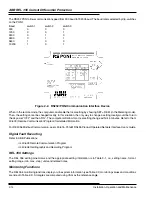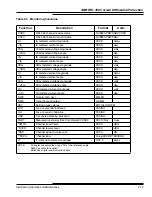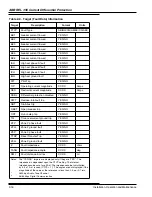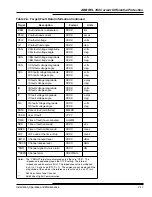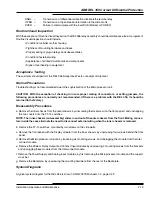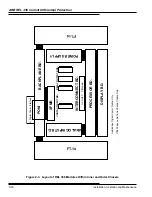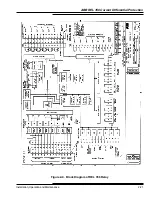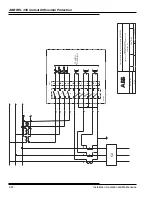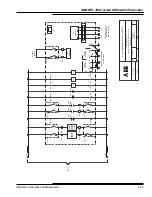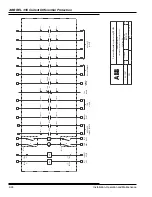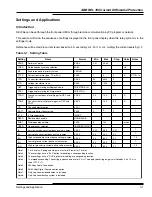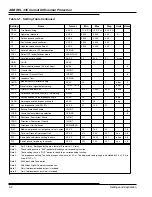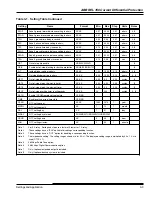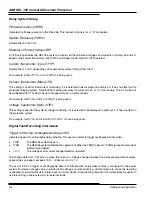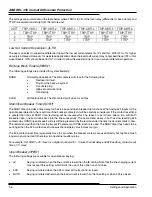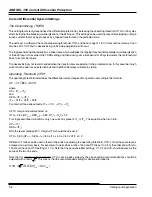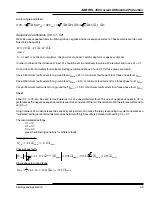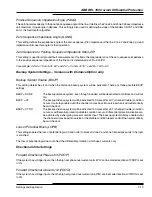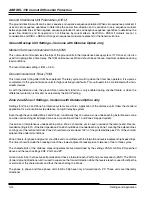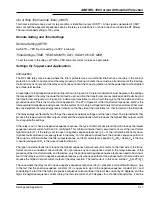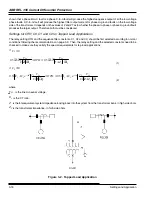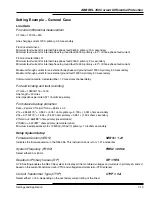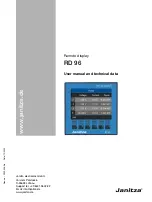
ABB REL 356 Current Differential Protection
3-4
Settings and Application
Relay System Setup
Firmware Version (VERS)
Indicates the firmware version in the REL 356. This instruction book is for v 1.21 and earlier.
System Frequency (FREQ)
Select either 50 or 60 Hz.
Readout in Primary Values (RP)
A YES setting enables the REL 356 system to display all the monitored voltages and currents in primary kA and kV,
based on the current transformer ratio (CTR) and voltage transformer ratio (VTR) entered.
Current Transformer Type (CTYP)
Select either 1 or 5 A, depending on the secondary current rating of the line ct.
For example: Enter CTYP = 5 if a 1200/5 ct is being used.
Current Transformer Ratio (CTR)
This setting is used for load current monitoring, if it is selected to be displayed in primary kA. It has no effect on the
protective relaying system. Note that the metering accuracy for currents is 5% or 0.1 A secondary. The 0.1 A step will
be multiplied with CTR, why the error will appear larger on a primary basis.
For example: Set CTR = 240 if a 1200/5 ct is being used.
Voltage Transformer Ratio (VTR)
This setting is used for the system voltage monitoring, if it is selected to be displayed in primary kV. It has no effect on
the protective system.
For example: Set VTR = 575 if 69,000 V to 120 V vt’s are being used.
Digital Fault Recording Information
Trigger for Storing Oscillographic Data (OSC)
Indicates trigger for oscillographic data gathering. The user can select to trigger oscillographic data when:
·
TRIP
The REL356 system tripped
·
ITRG
The REL356 system detected the operation of either the TRGP (phase) or TRGG (ground) overcurrent
elements (see below)
·
D
V
D
I
The voltage and/or current change detectors operated
The change detectors (CD) pick up when the current or voltage change between the corresponding data samples,
spaced one cycle apart, exceeds 12.5%, minimum 0.5 A or 7 V.
The use of CD as a trigger of oscillographic data is of little practical value when a relay is connected to the power
system. Numerous changes due to sudden load changes, remote switching, distant faults, etc. make the resulting
oscillographic records difficult to relate to events of importance. During testing however, it can sometimes be useful to
use this setting to capture records for external faults.
Summary of Contents for REL 356
Page 23: ...ABB REL 356 Current Differential Protection 1 10 Product Overview and Specifications ...
Page 83: ...ABB REL 356 Current Differential Protection 3 36 Settings and Application ...
Page 127: ...ABB REL 356 Current Differential Protection 5 28 Testing ...
Page 186: ...LINE SECTIONALIZING USING A PLC AND ABB PROTECTIVE RELAY Page 49 of 53 ...
Page 187: ...LINE SECTIONALIZING USING A PLC AND ABB PROTECTIVE RELAY Page 50 of 53 ...
Page 188: ...LINE SECTIONALIZING USING A PLC AND ABB PROTECTIVE RELAY Page 51 of 53 ...
Page 189: ...LINE SECTIONALIZING USING A PLC AND ABB PROTECTIVE RELAY Page 52 of 53 ...

